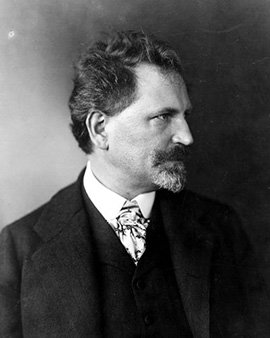The turn of the 19th and 20th centuries heralded a great upheaval in the visual arts - currents such as Impressionism or Symbolism emerged, which increasingly asserted themselves against Naturalism. New ideas and possibilities of expression broke the old academic rules in painting. Even Alphonse Mucha lived in the "homeland" of Impressionism and managed to reflect the spirit of the times in his works.
The artist had a talent which, together with his many experiences, slowly developed into his own style. But the path to art education was not without difficulties: in 1877 he tried to enrol at the Academy of Fine Arts in Prague, but was rejected by Professor Antonin Lhota. Two years later he travelled to Vienna and made theatre decorations. This gave him many skills in working with large formats and a feeling for theatre composition.
When Alphonse Mucha lacked money, he made portraits to earn his living. After a few commissions, which he carried out for Count Khuen-Belassi, he received financial support from the owner of the Nikolsburg. However, this stopped in 1877 and Mucha had to make designs for stamps. During this time he completed his studies at the Munich Art Academy, moved to Paris and joined the Colarossi Academy. In the capital Alphonse Mucha experienced the peak of his artistic work. He earned his living with numerous decorative works: drawings for model sheets, book illustrations and posters as well as other works. Meanwhile, Symbolist ideas are becoming increasingly evident.
In some places, repetitions and attenuations can be found in his work, for example in the production of the vast numbers of postcards and posters. Only a few changes in the design of the figures can be noticed. The gestures, facial expressions and decorations were modified; the background consisted of circles or arcs. But the works of Alphonse Mucha also have striking elements. The artist developed his own style, which he experimented with: the clearly visible lines, the ornamentation and the colouring, for example, made a typical representation of a woman with flowers unique.
Two Parisian exhibitions of the artist were very famous: in the gallery La Bodiniere and in the Salon des Cent. Afterwards, in 1904, Mucha travelled to the United States and settled there for some time to carry out commissions from there.
In the second half of his life, he studied Slavicism for the work "The Slavic Epic". He travelled to Poland and Russia. It was not until 1928 that he handed over the painting to the city of Prague, where it got its own place in the Exhibition Palace. In 1938 Mucha suffered pneumonia and died the following year.
×





.jpg)
.jpg)
.jpg)
.jpg)
.jpg)
.jpg)
.jpg)
.jpg)
.jpg)
.jpg)
.jpg)
.jpg)
.jpg)
.jpg)
.jpg)
.jpg)
.jpg)
.jpg)
.jpg)
.jpg)
.jpg)
.jpg)
.jpg)
.jpg)
_-_(MeisterDrucke-902547).jpg)
_-_(MeisterDrucke-902547).jpg)
.jpg)
.jpg)
.jpg)
.jpg)
.jpg)
.jpg)
_for_the_Cognac_Bisquit_Dubouche_-_(MeisterDrucke-646339).jpg)
_for_the_Cognac_Bisquit_Dubouche_-_(MeisterDrucke-646339).jpg)
.jpg)
.jpg)
 1896 (lithograph) - (MeisterDrucke-139261).jpg)
 1896 (lithograph) - (MeisterDrucke-139261).jpg)
.jpg)
.jpg)
.jpg)
.jpg)
.jpg)
.jpg)
.jpg)
.jpg)
.jpg)
.jpg)
.jpg)
.jpg)
_for_the_fragrance_Sylvanis_esse_-_(MeisterDrucke-659971).jpg)
_for_the_fragrance_Sylvanis_esse_-_(MeisterDrucke-659971).jpg)
.jpg)
.jpg)
.jpg)
.jpg)
.jpg)
.jpg)
.jpg)
.jpg)
.jpg)
.jpg)
.jpg)
.jpg)
.jpg)
.jpg)
.jpg)
.jpg)
.jpg)
.jpg)
.jpg)
.jpg)
.jpg)
.jpg)
.jpg)
.jpg)
.jpg)
.jpg)
.jpg)
.jpg)
 entitled The flower ser - (MeisterDrucke-640591).jpg)
 entitled The flower ser - (MeisterDrucke-640591).jpg)
_-_(MeisterDrucke-659967).jpg)
_-_(MeisterDrucke-659967).jpg)
.jpg)
.jpg)
_for_the_magazine_La_plume_1896_-_Poster_ill_-_(MeisterDrucke-659969).jpg)
_for_the_magazine_La_plume_1896_-_Poster_ill_-_(MeisterDrucke-659969).jpg)
.jpg)
.jpg)
.jpg)
.jpg)
 - (MeisterDrucke-133605).jpg)
 - (MeisterDrucke-133605).jpg)
 - (MeisterDrucke-130410).jpg)
 - (MeisterDrucke-130410).jpg)
 18 - (MeisterDrucke-640593).jpg)
 18 - (MeisterDrucke-640593).jpg)
.jpg)
.jpg)
.jpg)
.jpg)
.jpg)
.jpg)
.jpg)
.jpg)
.jpg)
.jpg)
.jpg)
.jpg)
.jpg)
.jpg)
.jpg)
.jpg)
.jpg)
.jpg)
.jpg)
.jpg)
_Colour_lithograph_-_(MeisterDrucke-941436).jpg)
_Colour_lithograph_-_(MeisterDrucke-941436).jpg)
.jpg)
.jpg)
.jpg)
.jpg)
.jpg)
.jpg)
.jpg)
.jpg)
.jpg)
.jpg)
.jpg)
.jpg)
.jpg)
.jpg)
.jpg)
.jpg)
.jpg)
.jpg)
.jpg)
.jpg)
.jpg)
.jpg)
.jpg)
.jpg)
.jpg)
.jpg)
.jpg)
.jpg)
_-_(MeisterDrucke-684664).jpg)
_-_(MeisterDrucke-684664).jpg)
.jpg)
.jpg)
.jpg)
.jpg)
.jpg)
.jpg)
.jpg)
.jpg)
.jpg)
.jpg)
.jpg)
.jpg)
.jpg)
.jpg)
.jpg)
.jpg)
.jpg)
.jpg)
.jpg)
.jpg)
.jpg)
.jpg)
.jpg)
.jpg)
.jpg)
.jpg)
.jpg)
.jpg)
.jpg)
.jpg)
.jpg)
.jpg)
.jpg)
.jpg)
.jpg)
.jpg)
.jpg)
.jpg)
.jpg)
.jpg)
.jpg)
.jpg)
.jpg)
.jpg)
.jpg)
.jpg)
.jpg)
.jpg)
.jpg)
.jpg)






